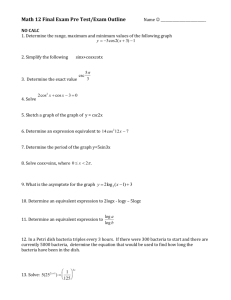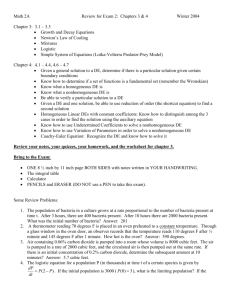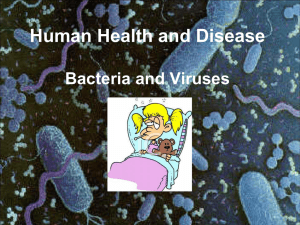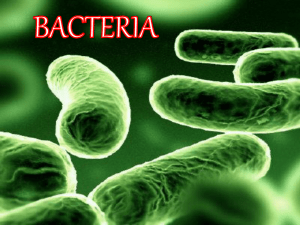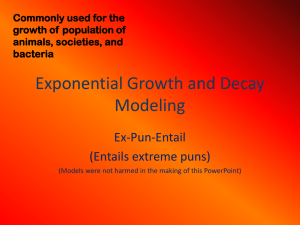NEW Calculus 30 Unit 1 - Polynomial
advertisement
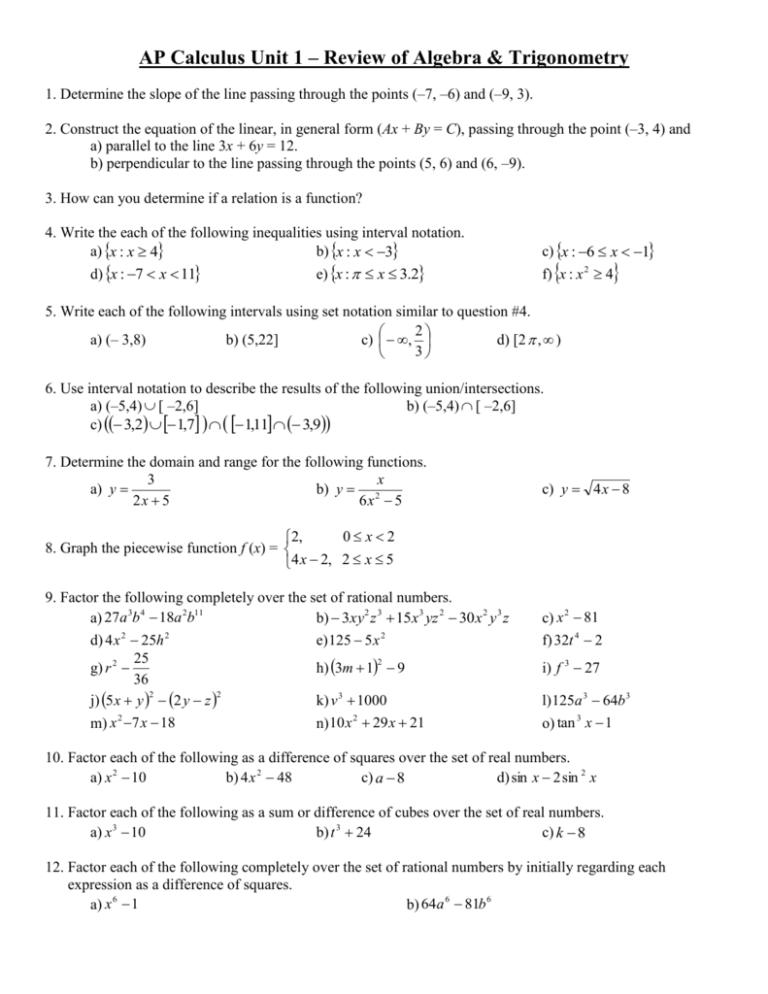
AP Calculus Unit 1 – Review of Algebra & Trigonometry 1. Determine the slope of the line passing through the points (–7, –6) and (–9, 3). 2. Construct the equation of the linear, in general form (Ax + By = C), passing through the point (–3, 4) and a) parallel to the line 3x + 6y = 12. b) perpendicular to the line passing through the points (5, 6) and (6, –9). 3. How can you determine if a relation is a function? 4. Write the each of the following inequalities using interval notation. a) x : x 4 b) x : x 3 d) x : 7 x 11 e) x : x 3.2 c) x : 6 x 1 f) x : x 2 4 5. Write each of the following intervals using set notation similar to question #4. 2 a) (– 3,8) b) (5,22] c) , d) [2 , ) 3 6. Use interval notation to describe the results of the following union/intersections. a) (–5,4) [ –2,6] b) (–5,4) [ –2,6] c) 3,2 1,7 1,11 3,9 7. Determine the domain and range for the following functions. 3 x a) y b) y 2 2x 5 6x 5 c) y 4 x 8 0 x2 2, 8. Graph the piecewise function f (x) = 4 x 2, 2 x 5 9. Factor the following completely over the set of rational numbers. a) 27a 3b 4 18a 2b11 b) 3xy2 z 3 15 x 3 yz 2 30 x 2 y 3 z d) 4 x 2 25h 2 e) 125 5 x 2 25 2 g) r 2 h) 3m 1 9 36 2 2 j) 5 x y 2 y z k) v 3 1000 m) x 2 7 x 18 n) 10 x 2 29 x 21 c) x 2 81 f) 32t 4 2 i) f 3 27 l) 125a 3 64b 3 o) tan 3 x 1 10. Factor each of the following as a difference of squares over the set of real numbers. a) x 2 10 b) 4 x 2 48 c) a 8 d) sin x 2 sin 2 x 11. Factor each of the following as a sum or difference of cubes over the set of real numbers. a) x 3 10 b) t 3 24 c) k 8 12. Factor each of the following completely over the set of rational numbers by initially regarding each expression as a difference of squares. a) x 6 1 b) 64a 6 81b 6 13. Factor each of the following completely over the set of rational numbers by initially regarding each expression as a difference of cubes. a) x 6 1 b) 64a 6 81b 6 14. By examining the discriminant, determine which of the following trinomials can be factored over the set of rational numbers. a) x 2 4 x 16 b) 6 x 2 5 x 56 c) 8 x 2 5 x 48 d) x 2 3x 9 15. Factor each of the following so that the second factor contains no negative exponents or rational coefficients. 1 1 3 3 2 3 2 1 12 12 x y x y a) 2 x 3 12 x 2 b) 16b 2 12b 2 c) 20 15 16. Factor each of the following polynomials over the set of rational numbers using the factor theorem. a) x 3 7 x 6 b) x 4 x 3 11x 2 9 x 18 c) 6 x 4 x 3 8 x 2 x 2 17. Evaluate the following composite functions if f(x) = 3x – 7, g(x) = 2x2 + 7 and h(x) = 6 – 3x. a) g f h 2 b) f f g 7 c) h g hx 18. Construct the equation of the polynomial functions whose graphs are shown below. a) b) y y x x 19. Construct the graph for each of the following polynomial functions. 2 3 4 3 2 2 a) y 5 x 3 x 2 x 1 x 4 b) y 2 x 4 x 3 x 5 20. Determine the value(s) of x, if any, for which each function is a) zero, b) undefined, and c) indeterminate. x3 x2 4 x3 x 2 f x a) f x b) f x c) x2 x2 2 2 3 2 x 3x 18 x 4x2 x 4 x 3 f x d) f x e) f) f x x3 6x 2 x3 1 x 3 xlog 2 x x 4 3x 3 2 x 2 12 x 8 2x 8 f x f x g) f x h) i) x 4 7 x 2 12 sin x 4 2x 21. Construct the graph for each of the following functions rational functions. x x2 a) y b) y 2 x5 x 2x 3 c) y 22. Construct the reciprocal function for each of the following polynomial functions. 2 a) y 3x 6 b) y 2x 3x 7 x 6 23. Sketch the graph of the polynomial and the reciprocal functions from questions #22. x2 9 x 3 16 x 24. Construct the inverse relation for each of the following functions. 4 a) y 3x 8 b) f x x3 c) f x x 2 4 25. Which of the inverse relations from question #24 are functions? 26. An even function is symmetrical with the ___ axis. 28. Evaluate each of the following. a) 25 b) 3.025 27. An odd function is symmetrical with the _____. c) 5 2 d) 5 2 29. Solve each of the following and express your answer using interval notation. a) 3x 7 20 b) x 2 3 x 3 1 c) x 4 3x 2 7 x 12 6 2 1 e) 2 x 6 12 3x 4 3 30. Sketch the following absolute value functions. a) y 3 b) y x c) y 2 x 8 d) e) y x 3 8 f) y sin x g) y x 3 4 x 31. Sketch the graph of the following absolute value functions. a) f x 7 x 8 b) f x x 2 6 x 16 f) 3x 1 10 d) y 25 x 2 h) y log 2 x c) y x 1x 7 x 5 2 32. Solve each of the following inequalities. Write the solution using set and interval notation. 2 x 5 3x 4 x 7 1 a) 5x 32x 4 2x 3 b) 3 2 6 c) x 2 5 x 6 0 d) 3 x 2 6 x e) 9 x 2 6 x 1 f) 11x 35 6 x 2 g) x 2 9 x 25 h) x 3 2 x 2 x 2 0 33. The length of a rectangle is 10cm more than twice the width. If the perimeter of the rectangle is less than 62 cm, determine the possible dimensions of the width. 34. Two numbers have a sum of 10. If their product must be larger than –75, determine the possible values for each number. 35. Evaluate the following equations a) x4 = 11181 d) 6x9 = 1500 b) 6x = 7121 e) log314 = x c) 312 = x f) logx15678 = 11 36. Escherichia coli double in number every 20 minutes. Determine how long it would take for 10 million of the bacteria to exist assuming you started with 2 bacteria and none of the bacteria expire. 37. Bacillus thermophiles double in number every 18.3 minutes. Determine the number of bacteria that would exist in one week assuming you started with 10 bacteria and none of the bacteria expire. 38. Streptococcus lactis double in number every 30 minutes. How many bacteria would you have had originally if you have 485 thousand bacteria after one week. 39. Determine the doubling time of a certain bacteria if it takes 2 weeks for 10 bacteria to grow to 1 million.
